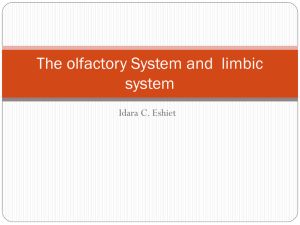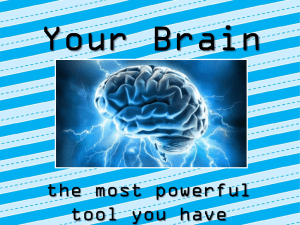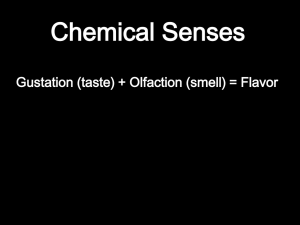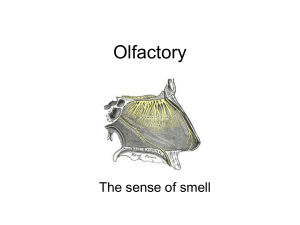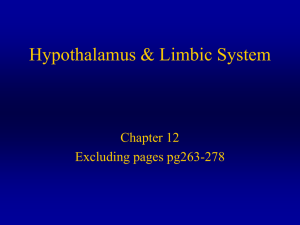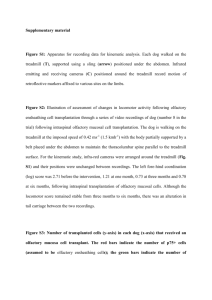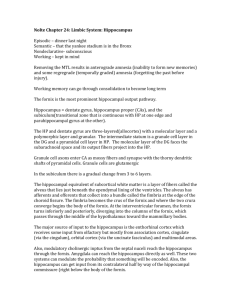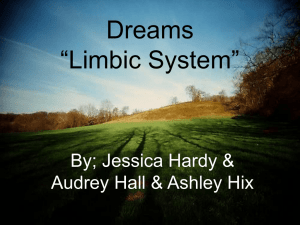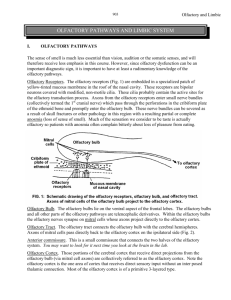Neuroscience 14c – The Limbic System and Drugs of Abuse
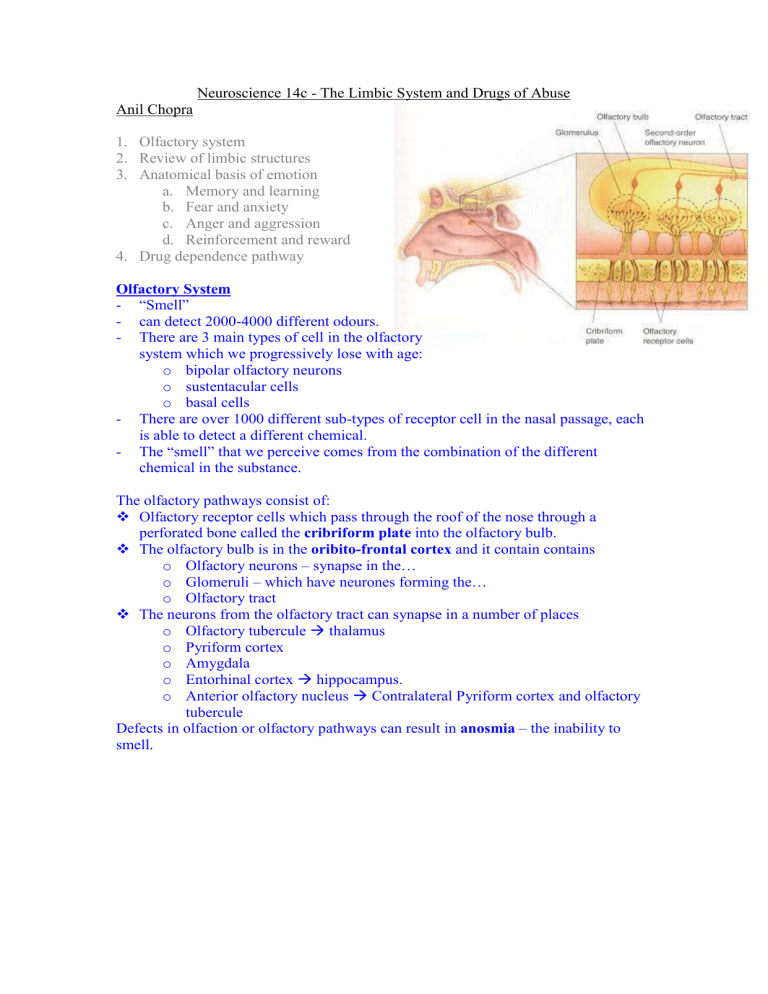
Neuroscience 14c - The Limbic System and Drugs of Abuse
Anil Chopra
1.
Olfactory system
2.
Review of limbic structures
3.
Anatomical basis of emotion a.
Memory and learning b.
Fear and anxiety c.
Anger and aggression d.
Reinforcement and reward
4.
Drug dependence pathway
Olfactory System
-
“Smell”
can detect 2000-4000 different odours.
There are 3 main types of cell in the olfactory system which we progressively lose with age: o bipolar olfactory neurons o sustentacular cells o basal cells
There are over 1000 different sub-types of receptor cell in the nasal passage, each is able to detect a different chemical.
The “smell” that we perceive comes from the combination of the different chemical in the substance.
The olfactory pathways consist of:
Olfactory receptor cells which pass through the roof of the nose through a perforated bone called the cribriform plate into the olfactory bulb.
The olfactory bulb is in the oribito-frontal cortex and it contain contains o Olfactory neurons – synapse in the… o Glomeruli – which have neurones forming the… o Olfactory tract
The neurons from the olfactory tract can synapse in a number of places o Olfactory tubercule
thalamus o Pyriform cortex o Amygdala o Entorhinal cortex
hippocampus. o Anterior olfactory nucleus
Contralateral Pyriform cortex and olfactory tubercule
Defects in olfaction or olfactory pathways can result in anosmia – the inability to smell.
Limbic System
The limbic system contains many parts all of which are interrelated. The system responsible for this processes aimed at survival: o maintenance of homeostasis via activation of visceral effector mechanisms, modulation of pituitary hormone release and initiation of feeding and drinking o agonistic (defence & attack) behaviour o sexual & reproductive behaviour o memory
The pre-dominant outflow of the limbic system is to the pre-frontal cortex and hypothalamus as well as to the cortical areas involved in planning of behaviour and motor responses
Thus the limbic system has a role in attaching a behavioural significance and response to a stimulus – especially in respect to emotional content
Put simply: hypothalamic mammillary bodies → anterior nucleus of the thalamus → cingulate gyrus → parahippocampal gyrus → entorhinal cortex → hippocampus → fornix → hypothalamus
Cingulate Gyrus : receives input from the anterior nucleus of the thalamus and the neocortex and projects onto the parahippocampal gyrus via the cingulum .
Parahippocampal Gyrus : part of the brain that contains entorhinal and perihinal cortices.
Entorhinal Cortex : an important memory and learning centre in the brain especially for classical conditioning. It receives inputs from a number of different senses and projects onto the hippocampus.
Hippocampus : a part of the forebrain, located in the medial temporal lobe. There is one on each side of the brain projecting onto the fornix/fimbria. It receives input from the perforant pathways.
Fornix : the fornix is a C-shaped bundle of fibres that project from hippocampus to the mammilary bodies. It splits and forms, on either side of the brain, the 2 crus of the fornix. These then join together in the midline of the brain to form the body of the fornix which then splits again into the 2 columns of the fornix to project onto the mammillary bodies.
Mammillary Bodies : two round bodies on the anterior of the fornix which form part of the limbic system. They contain two sets of nuclei, the lateral mammillary nuclei and the medial mammillary nuclei. They receive input from the hippocampus and the amygdala and project onto the thalamus via the mamillo-thalamic tract.
Amygdala : groups of neurones in the medial temporal lobes. These are subdivded:
Basolateral complex – receive impulses from a number of sensory systems it is split into
Later
Basal
Accessory
Centromedial nuclei - receive impulses from a number of sensory systems.
Cortical nucleus – receives information from olfactory bulb and olfactory nuclei.
These project into the hypothalamus via the stria terminalis and the ventral amygdalofugal pathway. It also projects onto the reticular nucleus for increased reflexes, to the nuclei of the trigeminal nerve and facial nerve for facial expressions of fear, and to the ventral tegmental area, locus coeruleus, and laterodorsal tegmental nucleus for activation of dopamine, noradrenaline and adrenaline.
Septum: lies beneath the rostral corpus callosum. Receives input from the amygdala, olfactory tract, hippocampus and brainstem. It projects onto the stria medularis thalami, hippocampus and hypothalamus. It is involved with reward and reinforcement of behaviours.
The Papez circuit is a pathway of the limbic system that is used to explain emotional behaviour. brain systems involved in fear & anxiety, anger
& aggression and reinforcement & reward
Emotional colouring
Emotional experience
Anterior Nucleus of Thalamus
Neocortex
Cingulate cortex
Cingulum bundle
Hippocampus
MTT
Emotional expression
Fear and Anxiety:
Principally due to the Amygdala
Hypothalamus
A small almond shaped structure in the medial aspect of the temporal lobe
Involved in the learning and storage of the emotional aspects of expierence
Afferent connections – olfactory cortex, septum, temporal neocortex,
Fornix hippocampus, brainstem
Efferent connections – stria terminalis
Clinical – Kluver-Bucy Syndrome
Aggression:
“Sham Rage”
Structures shown to be associated with aggression:
Hypothalamus
Brainstem – periqueductal grey matter
Amygdala
Reinforcement and Reward:
Principally due to the Septum
Afferent connections – amygdale, olfactory tract, hippocampus, brainstem
Efferent connections – stria medularis thalami, hippocampus, hypothalamus
Memory and Learning:
Principally due to the hippocampus :
Afferent connections – perforant pathway
Efferent pathways – Fimbrial/fornix
Clinical – Alzheimar’s disease, Parkinson’s
Clinical Conditions
Alzheimer’s Disease
Can manifest itself in the hippocampus. It is caused by plaques in the region and can spread making it a degenerative disease. It normally starts in the hippocampus and entorhinal cortex and spread to the parietal lobe and the frontal lobe:
Early
–
Hippocampus and entorhinal cortex
–
Short-term memory problems
Moderate
–
Parietal lobe
–
Dressing apraxia
Late
–
Frontal lobe
–
Loss of executive skills
Kluver-Bucy Syndrome
Caused by defects in the amygdala. It can cause:
–
Loss of fear
– Visual agnosia – inability to recognise objects
–
Hyperorality – inappropriate exploratory behaviour
–
Hypersexuality – inappropriate sexual behaviour
Anger and Aggression
The hypothalamus, brainstem and amygdala are all shown to associate with feelings of anger and aggression. Defects can result in “sham rage” – easy aggregation by provocation. 5-HT (serotonin) in raphe nuclei are also associated with anger.
Drug Dependence
Dependence on drugs is associated with the Mesolimbic dopaminergic pathway. The dompaminergic cells cause the release of dopamine which travels along the median forebrain bundle to 3 main structures: the cortex, nucleus accumbens and the amygdala. The dopamine may have several effects including euphoria. Repeated exposure can lead to dependence due to a lessened effect of dopamine (caused by down-regulation of dopamine receptors). Opiates, amphetamines, nicotine, ethanol and cocaine all increase the release of dopamine in the nucleus accumbens.
M I I D B R A I I N
( ( A 1 0 )
M F B
C o r t t e x
N u c l l e u s a c c u m b e n s
A m y g d a l a
